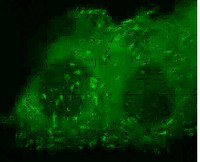17-10154 Sigma-AldrichLentiBrite™ Paxillin-GFP Lentiviral Biosensor
Recommended Products
Overview
| Replacement Information |
|---|
Key Specifications Table
| Key Applications | Detection Methods |
|---|---|
| TFX, IF, ICC | Fluorescent |
| Description | |
|---|---|
| Catalogue Number | 17-10154 |
| Trade Name |
|
| Description | LentiBrite™ Paxillin-GFP Lentiviral Biosensor |
| Overview | Read our application note in Nature Methods! http://www.nature.com/app_notes/nmeth/2012/121007/pdf/an8620.pdf (Click Here!) Learn more about the advantages of our LentiBrite Lentiviral Biosensors! Click Here Biosensors can be used to detect the presence/absence of a particular protein as well as the subcellular location of that protein within the live state of a cell. Fluorescent tags are often desired as a means to visualize the protein of interest within a cell by either fluorescent microscopy or time-lapse video capture. Visualizing live cells without disruption allows researchers to observe cellular conditions in real time. Lentiviral vector systems are a popular research tool used to introduce gene products into cells. Lentiviral transfection has advantages over non-viral methods such as chemical-based transfection including higher-efficiency transfection of dividing and non-dividing cells, long-term stable expression of the transgene, and low immunogenicity. EMD Millipore is introducing LentiBrite™ Lentiviral Biosensors, a new suite of pre-packaged lentiviral particles encoding important and foundational proteins of autophagy, apoptosis, and cell structure for visualization under different cell/disease states in live cell and in vitro analysis.
EMD Millipore’s LentiBrite™ Paxillin-GFP lentiviral particles provide bright fluorescence and precise localization to enable live cell analysis of autophagy in difficult-to-transfect cell types. |
| Background Information | Adherent cells maintain contact with the extracellular substratum by means of focal adhesions, comprising transmembrane matrix receptors (integrins) linked on their cytoplasmic side to a complex of signaling and structural proteins linked to the cytoskeleton. Paxillin, one of the first proteins recruited to nascent adhesions, serves as a scaffolding protein for kinases (Src, FAK), GTP exchange factors and other structural proteins, and plays a key role in assembly and disassembly of focal adhesions. Focal adhesions are highly dynamic structures that assemble at the leading edge of the migrating cell and disassemble at the trailing edge. Fusions between paxillin and fluorescent proteins have been widely employed for analysis of focal adhesion dynamics in live cells. EMD Millipore’s LentiBrite™ Paxillin-GFP lentiviral particles provide bright fluorescence and precise localization to enable live cell analysis of focal adhesion dynamics in difficult-to-transfect cell types. |
| References |
|---|
| Product Information | |
|---|---|
| Components |
|
| Detection method | Fluorescent |
| Quality Level | MQ100 |
| Biological Information | |
|---|---|
| Gene Symbol |
|
| Purification Method | PEG precipitation |
| UniProt Number | |
| Physicochemical Information |
|---|
| Dimensions |
|---|
| Materials Information |
|---|
| Toxicological Information |
|---|
| Safety Information according to GHS |
|---|
| Safety Information |
|---|
| Product Usage Statements | |
|---|---|
| Quality Assurance | Evaluated by transduction of HT-1080 cells at MOI values of 20 and 40. Fluorescent imaging performed for assessment of target localization and transduction efficiency. |
| Usage Statement |
|
| Packaging Information | |
|---|---|
| Material Size | 1 vial (minimum of 3 x 10E8 IFU/mL) |
| Transport Information |
|---|
| Supplemental Information |
|---|
| Specifications |
|---|
| Global Trade Item Number | |
|---|---|
| Catalog Number | GTIN |
| 17-10154 | 04053252640001 |
Documentation
LentiBrite™ Paxillin-GFP Lentiviral Biosensor SDS
| Title |
|---|










